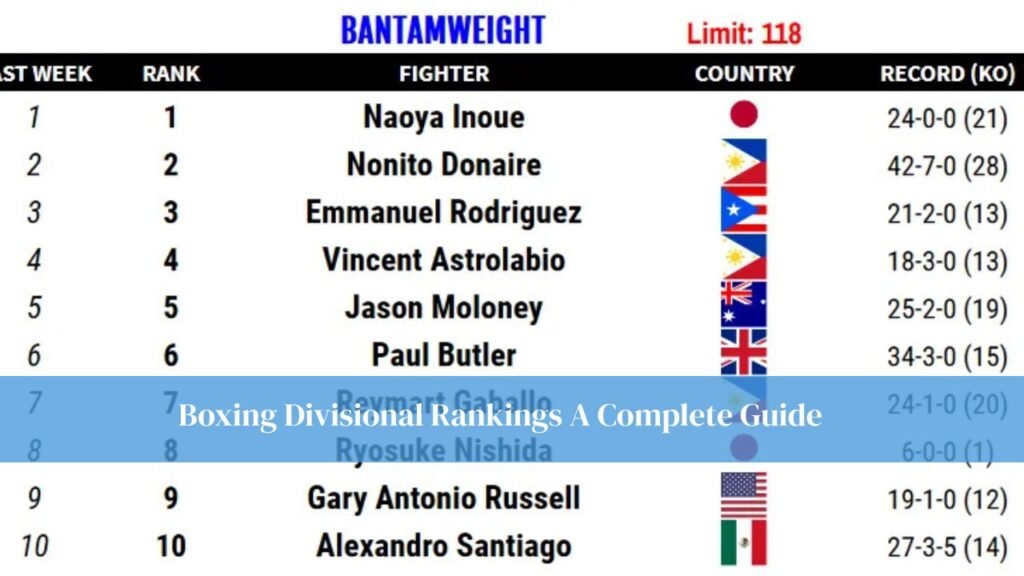Boxing is not only about power punches, roaring crowds, or title belts; it is a sport built on structure, order, and a carefully crafted system of competition. One of the most important elements of this system is the boxing divisional rankings, a framework that determines which fighters are at the top of their divisions and which challengers are next in line. Fans may argue endlessly about who the best fighter is, but the rankings serve as a reference point for fighters, promoters, and even broadcasters to decide who deserves the spotlight.
Without rankings, boxing would be chaotic. Fighters would have little clarity about their career paths, promoters would struggle to organize meaningful fights, and fans would be left confused about who truly belongs among the elite. The divisional ranking system brings discipline to a sport that thrives on unpredictability. It ensures that athletes fight within their categories, rise through merit, and eventually reach the championship stage. For anyone who wants to move beyond casual fandom and into a deeper appreciation of the sport, understanding divisional rankings is essential.
The Importance of Boxing Divisional Rankings
The rankings are more than a list of names. They symbolize recognition, opportunity, and career growth. When a boxer climbs the rankings, it signals to the boxing world that they are among the most skilled and deserving fighters of their generation. This recognition often opens doors to bigger fights, larger purses, and increased media exposure. Fans begin to follow them more closely, brands start offering sponsorships, and promoters arrange higher-profile matches.
Rankings also give legitimacy to the competition. In an individual sport where careers can hinge on a single punch, rankings serve as the measuring stick that determines who gets a chance at greatness. They prevent the sport from devolving into a free-for-all and create an organized pathway for fighters to pursue championship opportunities. Without them, many skilled fighters could easily be overlooked while less deserving athletes dominate the spotlight due to marketing or personal connections.
How Divisional Rankings Are Determined
Official Sanctioning Bodies
The world of boxing is governed by four major sanctioning bodies: the World Boxing Association (WBA), World Boxing Council (WBC), International Boxing Federation (IBF), and World Boxing Organization (WBO). Each of these organizations maintains its own divisional rankings, updated regularly to reflect recent performances. While they share the common goal of ranking fighters based on merit, their methods often differ, leading to debates among fans about which system is the most reliable.
Criteria for Rankings
Several factors contribute to a fighter’s position in the rankings. Recent victories carry the most weight, but the quality of the opponent matters just as much as the outcome. A win against a top contender is valued far higher than a victory over a lesser-known fighter. Fighters who remain active and consistent tend to climb more quickly, while inactivity often causes a drop in rankings. Losses, particularly against lower-ranked fighters, can severely damage a boxer’s standing.
Despite these criteria, transparency is often a problem. Fans frequently question why a fighter who has not fought in over a year still holds a high ranking, while others who are actively winning remain stuck at lower positions. This criticism has led many to believe that politics, promotional power, and financial incentives also play significant roles in determining who rises and who stagnates.
Boxing Weight Divisions Explained
Lightweight to Middleweight
The lighter divisions, which include categories such as lightweight, featherweight, and welterweight, are celebrated for their fast pace, endurance, and technical brilliance. Fighters in these weight classes rely on speed, timing, and precision. Their fights often showcase the art of boxing in its purest form, where footwork and defense can be just as important as offensive power. Fans who appreciate strategy and skill tend to follow these divisions closely.
Middleweight to Heavyweight
As the weight divisions progress upward, the emphasis shifts toward strength and knockout power. Middleweights offer a balance of speed and strength, delivering matches that are both technical and explosive. The light heavyweight and heavyweight divisions are the most physically demanding categories, where a single punch can end a fight instantly. Heavyweight boxing, in particular, has long been considered the glamour division, producing global icons who transcend the sport.
The Role of Multiple Divisions
Boxing’s many divisions exist to ensure fairness. Without weight categories, smaller fighters would be forced to compete against much larger opponents, which could endanger their health and skew the competition. Divisions not only create balance but also allow for diversity. Fans can enjoy a variety of styles and matchups, from lightning-fast featherweights to hard-hitting heavyweights. The boxing divisional rankings within each class ensure that the best contenders are recognized and rewarded with opportunities to fight for titles.
Global Impact of Divisional Rankings
Rankings are not just about fighters; they influence the sport globally. They help build international stars who carry the sport into new markets and regions. For example, the Indian Boxing Council (indianboxingcouncil.com) plays a major role in developing boxing talent in South Asia, giving fighters from the region a platform to be recognized internationally. In the United Kingdom, platforms such as Fight Zone (fightzone.uk) help bring visibility to fighters who might otherwise remain unknown outside their local circuits.
Even military institutions contribute to rankings indirectly. Programs like British Army Boxing (britisharmyboxing.com) provide training and competition opportunities that prepare fighters for professional careers. Many champions began their journeys in military or amateur programs, where their early performances shaped their rankings and reputations.
The commercial side of boxing also ties into rankings. Stores like Pro Boxing Store (proboxingstore.com) supply fighters and fans with gear, while platforms like Made4Fitness (made4fitness.com) focus on conditioning and training. Fighters who climb higher in the rankings often attract partnerships from such businesses, creating a cycle where rankings influence commercial opportunities, and commercial visibility further boosts their profiles.
The Debate Around Rankings
Rankings are often criticized for lacking fairness and transparency. Fans point out that inactive fighters sometimes maintain high positions while active fighters are overlooked. Critics argue that promotional power often plays too big a role, with some promoters leveraging their influence to push fighters up the rankings faster than merit alone would allow.
Independent rankings, such as those published by ESPN (espn.com) or compiled on Wikipedia (wikipedia.org), are often considered more reliable by fans who seek transparency. These rankings tend to focus more on recent performance and less on commercial influence, offering a different perspective from the sanctioning bodies. Still, the discrepancies between different lists show how subjective the process can be.
Why Rankings Matter to Fans
For fans, rankings are more than statistics; they shape the stories that make boxing compelling. Watching a young fighter rise through the rankings builds anticipation for what could become a historic championship bout. Rankings also give context to fights, helping viewers understand whether a match is an eliminator, a warm-up, or a high-stakes title defense.
Modern broadcasting and streaming platforms amplify the importance of rankings. Services like Netflix (netflix.com) have explored boxing through documentaries and series, while venues like Allegiant Stadium (allegiantstadium.com) have hosted major ranking-driven fights. These platforms and venues extend the sport’s reach and highlight the global fascination with divisional standings.
Challenges Facing the Ranking System
One of the biggest challenges is the existence of multiple sanctioning bodies, each with its own champions and ranking lists. This often results in the same division having two or even three different champions at the same time, confusing fans and diluting the prestige of titles. Calls for unification have been ongoing for decades, yet no universal system has been implemented.
Another challenge is inactivity. When top-ranked fighters remain inactive due to negotiations, injuries, or contractual disputes, divisions can stagnate. Rising contenders may be left waiting for opportunities while the sport loses momentum. Addressing these issues will be crucial for ensuring the credibility of boxing divisional rankings in the future.
FAQs
How often are boxing divisional rankings updated?
Most sanctioning bodies update their rankings once a month. Independent outlets may adjust them more quickly, especially after major fights.
Do all sanctioning bodies agree on the same rankings?
No. Each sanctioning body has its own process, so a fighter might be ranked highly by one organization and much lower by another.
Can fighters move between divisions?
Yes. Fighters often move up or down in weight to challenge themselves or seek new opportunities. When they switch, they usually need to prove themselves in the new division before reaching the top.
Why do fans criticize boxing rankings?
Many fans feel that rankings are influenced by money and politics. They argue that promoters and broadcasters sometimes manipulate rankings to create lucrative fights.
Which division is considered the most prestigious?
The heavyweight division traditionally carries the most prestige because heavyweight champions are often seen as the most powerful fighters in the sport.
Conclusion
Boxing divisional rankings form the foundation of professional boxing. They ensure that fighters rise through a system that rewards performance, dedication, and consistency. While the process is not without flaws, and debates about transparency will likely continue, the rankings remain crucial for structuring the sport and creating pathways for fighters to reach championship status.
For fans, these rankings are more than statistics; they are the narratives that make the sport so compelling. Every climb up the ladder, every new contender breaking into the top ten, and every shift in position adds to the excitement of following boxing. Whether you are watching local fighters climb through smaller organizations or global superstars headlining massive events, rankings provide context and meaning.
If you are serious about following the sport, keeping track of boxing divisional rankings is essential. And for deeper coverage, expert breakdowns, and updates on the latest shifts in the boxing world, visit Boxing Essential for trusted insights and analysis.




